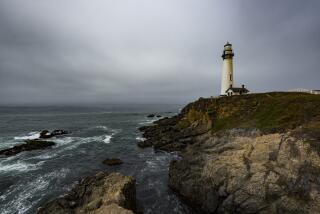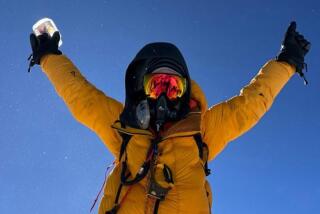By Air to Expo: A Peak Experience
SEATTLE â The adage âgetting there is half the funâ may prove true this summer if youâre flying to Seattle or Vancouver to visit Expo 86 and are blessed with a clear, sunny travel day.
Ask for a right-side window seat. If normal weather and wind conditions prevail, youâll be treated to spectacular and unforgettable views of the snowcapped chain of volcanoes forming the Cascade Range, from Lassen Peak in Northern California to Mt. Baker near the Canadian border (including the battered and still-steaming hulk of Mt. St. Helens, which erupted in 1980).
Your flight, one of Americaâs most breathtaking and a favorite of amateur volcanologists and geologists, first follows a route north along the San Andreas Fault to the San Francisco-Sacramento area, then turns inland and north to pass over the Cascades.
Hope for Helpful Pilot
The flight is about 2 hours 40 minutes long. The aircraft flies first out over the Pacific Ocean, then in along the coast. Your trip will be especially enjoyable if your pilot enjoys the flight, as many do, and provides occasional narration, helping you to pick out landmarks.
The long scar of the San Andreas Fault appears, disappears and reappears, paralleling the coast, an insignificant-looking ripple masking tremendous earth forces below the surface.
After an hour or so the plane turns northeast, cutting across the midpoint between San Francisco and Sacramento. After several minutes the southernmost volcano in the Cascades, 10,457-foot Lassen Peak, comes into view on the far right.
Although this snowcapped peak in the center of Lassen Volcanic National Park seems silent, it is considered by geologists to be an active volcano--capable of eruption, the only one in the continental United States besides Mt. St. Helens.
A few moments later youâll fly over the perfectly shaped, snowy cone of Mt. Shasta. At 14,162 feet itâs one of Californiaâs tallest mountains, most famous landmarks and the center of a vast recreation area of lakes and forests.
Moon-Like Terrain
Youâll have to look a little harder to see Lava Beds National Monument on the far right, close to the Oregon border. This region of ancient volcanic action has been protected because of its dramatic, moon-like terrain covered by lava tubes, cinder cones, deep caves and chasms and Indian pictographs.
Next, your flight takes you directly over Crater Lake National Park. If your pilot is friendly, and weâve never had an unfriendly one, heâll turn the plane so folks on both sides can get a good view.
Crater Lake, adjacent to Mt. Scott, is the remains of an enormous, ancient volcano that exploded. The dead, cold crater slowly filled with fresh water from rain and snow, forming the second-deepest lake in North America (about 2,000 feet), looking from above like an iridescent blue silver dollar.
Now a string of six snowcapped volcanic peaks appears, stretching up to Oregonâs northern border. First is Diamond Peak, then farther east, the North, South, and Middle Sister Peaks, all over 10,000 feet.
Almost immediately, 10,495-foot Jefferson Peak in the Warm Springs Indian Reservation comes into view. Then as you pass over Oregonâs capital, Portland, 11,239-foot Mt. Hood rises in the east. Like Shasta, itâs a perfect, snow-topped cone shape, and like all high mountains, it can be cold, unpredictable and dangerous.
Ravaged Landscape
Now you cross into Washington and over the misshapen hulk of Mt. St. Helens, about 8,400 feet high. During the 1980 eruption the volcanoâs northern wall blew off, leveling hundreds of square miles of forest and filling a darkened sky with ash.
From the plane youâll see the gaping hole in the mountainside, gray rubble strewing the lower slopes. You may also see what looks like smoke, because this volcano still rumbles, spewing steam and hot gases into the atmosphere.
Before leaving the area, look east for the imposing figure of 12,276-foot Mt. Adams. After a glimpse of the destruction caused by Mt. St. Helens, its huge size and the volume of snow on its summit are thought-provoking.
Now you begin your descent into the Seattle area. And suddenly you glimpse the most spectacular volcano in the chain, 14,410-foot Mt. Rainier, highest mountain in the contiguous 48 states.
Surrounded by national park forests and covered all year by ice and snow, eternal winter blows and swirls around the summit. According to geologists, Rainier boasts the largest single-peak glacial system in the United States.
Serious Climbers Only
Climbers who scale this peak require ice-climbing skills, including expertise with crampons, ropes and ice axes, and most make the two-day climb with a guide.
Finally, whether youâre landing in Seattle or flying on to Vancouver, as the plane circles you may catch a glimpse of Mt. Baker, far to the north and east, close to the Canadian border. At 10,778 feet itâs the highest peak in the North Cascades.
The minutes and the wonders of the Cascade Range have flown by. Now itâs time to enjoy the pleasures of Seattle, Vancouver and Expo 86.
Expo 86, in Vancouver, B.C., will be open through Oct. 13. Most major Western carriers fly daily from Los Angeles to Seattle and Vancouver.
Northwest Orient, Alaska Airlines, United Airlines, Western Airlines and PSA fly non-stop to Seattle. Air Cal and Continental Airlines have one-stop flights. To Vancouver International Airport you can book a non-stop flight with Canadian Pacific Air or Western Airlines.
More to Read
Sign up for The Wild
Weâll help you find the best places to hike, bike and run, as well as the perfect silent spots for meditation and yoga.
You may occasionally receive promotional content from the Los Angeles Times.






